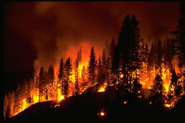30 April 2012

Wildfires — and other forms of burning biomass — can release the pollutant isocyanic acid. A new study models where the hot spots of this pollutant could be.
CREDIT: NOAA
WASHINGTON—In a new study, scientists have found that a pollutant, only recently observed, is likely to be at levels harmful to human health in several regions around the world. Researchers modeled the global distribution of isocyanic acid, a chemical found in smoke that is generated when biomass burns either through wildfires, inefficient stoves or other methods. Health problems associated with the chemical include inflammation linked to both cardiovascular disease and rheumatoid arthritis, and cataracts. The research, which will appear in the Journal of Geophysical Research-Atmospheres (an AGU publication), indicates that the pollutant is at times likely to be reaching harmful concentrations in areas of Africa, Southeast Asia, Siberia, and the Western Amazon Basin. For more information, visit AGU’s GeoSpace blog for a guest feature from NOAA.
Journalists and public information officers (PIOs) of educational and scientific institutions who have registered with AGU can download a PDF copy of this paper in press.
Or, you may order a copy of the final paper by emailing your request to Kate Ramsayer at [email protected]. Please provide your name, the name of your publication, and your phone number.
Neither the paper nor this press release are under embargo.
“Isocyanic acid in a global chemistry transport model: Tropospheric distribution and budget, and identification of regions with potential health impacts”
Paul J Young
Cooperative Institute for Research in Environmental Science (CIRES), University of Colorado Boulder, Boulder, Colorado, USA, and Chemical Sciences Division, NOAA Earth System Research Laboratory, Boulder, Colorado, USA;
Louisa K. Emmons
National Center for Atmospheric Research, Boulder, Colorado, USA;
James M. RobertsChemical Sciences Division, NOAA Earth System Research Laboratory, Boulder, Colorado, USA;
Jean-Francois Lamarque and Christine Wiedinmyer
National Center for Atmospheric Research, Boulder, Colorado, USA;
Patrick R VeresChemical Sciences Division, NOAA Earth System Research Laboratory, Boulder, Colorado, USA and Department of Chemistry and Biochemistry, University of Colorado, Boulder, Colorado, USA, now at Max Planck Institute for Chemistry, Mainz, Germany;
Trevor C VandenBoerDepartment of Chemistry, University of Toronto, Toronto, Ontario, Canada.
Contact Katy Human, NOAA public affairs, Telephone: 303-497-4747, Email: [email protected].